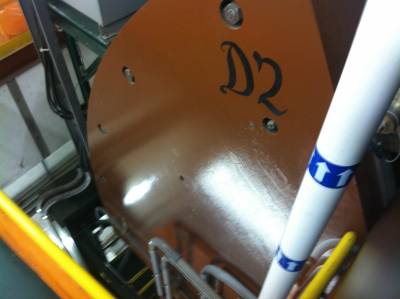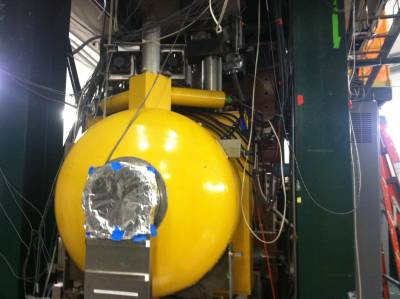Table of Contents
Magnets
This page provides a brief summary of the main characteristics of the S800 spectrograph magnets. For more detailed information, please check the PhD. dissertations:
Spectrograph Dipoles
Each S800 dipole weights 70 Tons and has a 15 cm gap. The bending radii and angle are 2.8 m and 75°, respectively. The magnet has five main pieces: two top slabs, the inner and outer side yokes, and the pole tip assembly. The maximum current supplied to the coil is 450 A, translating into a 1.6 T maximum central magnetic field, and a maximum magnetic rigidity of about 4 Tm. NMR probes are installed in the flat field region to measure the absolute field setting during operation. The dipole steel has a 30° edge angle, so that particles are defocused and focused in the dispersive and non-dispersive directions, respectively. Trim coils are installed on the inner and outer radii of the dipoles to achieve a uniform field near the edges of the magnet. The operating current of the trim coils is 43.75% the value of the magnets. A liquid helium feed circuit brings liquid helium through a heat exchanger at the top of the magnet and delivers the liquid into the bottom of the coils. The helium overflowing the coils fills the dewar to provide cooling for the incoming liquid. Liquid nitrogen is supplied at the bottom of each side. A 0.25 Ω dissipative resistor with a short decay constant is connected to a coil protection switch. In case of cryogenic failure, the switch reroutes the power supplied to the circuit into the resistor. The picture below (left figure) shows the second spectrograph dipole as seen from the top level of the S3 vault.
Spectrograph Quadrupole Doublet
In order to maximize the acceptance of the spectrograph, a doublet of superconducting quadrupoles is installed upstream of the two main dipoles. The doublet focuses the transmitted particles first in the non-dispersive and then in the dispersive directions. The quadrupoles are the iron-dominated type used in the NSCL beamlines, but with larger dimensions. The pole tip of each quad has a length of 30 cm and a radius of 12 cm for the first quad and 21 cm for the second one (i.e. almost twice and three times larger than the beamline quadrupoles, respectively). The doublet weights 5 Tons, including a sextupole installed at the end of the second quad. The field gradient of the first quadrupole is 19.7 T/m at a maximum operation current of 86 A. The field gradient of the second one is 7.5 T/m at a maximum operation current of 90 A. Both quadrupoles have cryogenic Hall generators mounted on the pole tips to measure the field gradient during operation. The quadrupoles don’t have protection circuit since they can quench with no damage to the coils. The picture above (right figure), shows the chamber (yellow) with the quadrupole doublet at the “entrance” of the spectrograph.
Spectrograph Sextupole
The only high-order magnet included in the S800 is a sextupole coil installed around the bore tube of the second quadrupole in the quadrupole-doublet of the spectrograph. The purpose of this element is to correct the broadening of the beam at the focal plane due to the dominant (x|b2) aberration. This defines a narrower trajectory of the beam, allowing the use of a beam blocker at the focal plane to block the unreacted beam when its magnetic rigidity is close to the tuned setting.



